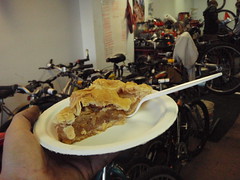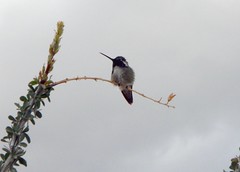Pardon the long post, but I have been thinking about these frescoes lately and want to put this out there tonight for some reason...
We have an amazing work of art in Minneapolis that I suspect most people may not even be aware of. The Minneapolis campus of the University of St. Thomas has a series of frescoes by artist Mark Balma that need to be seen to be believed. In fact, the atrium ceiling has one of the largest frescoes in the United States. I stop in here periodically to look at these and reflect on the meaning behind behind these images. I have taken co-workers who know nothing of the technique behind making a fresco, or the symbolism behind these images, and even they are awed by these.
The frescoes depict a modern interpretation of the seven virtues. Indeed, Balma's take on these is kind of surreal and bizarre, yet it's beautiful as well. Here are some short excerpts from the St. Thomas site describing these pieces to help make these more accessible:
Faith - Faith is the foundation of all of the other virtues. This is why Balma's depiction of the virtue is located at the entrance of the building. A family sits together peacefully beneath the golden sun. The sun provides energy to all living things and although we cannot gaze directly at it, we believe in its power. The family represents love and commitment. The child holds a small goldfinch, a Christian symbol for Christ because of its tendency to make nests from the seeds of the thorny thistle. The overall theme of this fresco is creation, and illustrated by the Native American teaching of the tortoise volunteering his back as a place for the people to live when there was no land.
Justice - Traditionally, the virtue of justice is depicted as a blindfolded woman holding equally balanced scales. Justice is meant to be blind; it does not make judgment based on prejudice. In Balma's interpretation, the scales become the main symbolism, with the images of male and female figures balanced perfectly upon them. The figures are not blind, but they see themselves as they are in their natural state, different and unique, but equal in respect to one another on a scale which is fixed. Behind them is the dark form of a stylized eagle, wings outstretched in an upward lift. The shape of this mythical bird was inspired by the "Thunderbird" of Native American folklore. Native people believed the eagle to be the mediator between heaven and earth, as it was able to soar effortlessly. It was considered the essence of spiritual enlightenment, of principles to be upheld. This representation of the eagle was adopted by early American colonists and became the symbol of our country. The entire piece is framed by a circle, a symbol of perfection.
Prudence - The virtue of prudence traditionally has been depicted by a figure of a teacher, denoting wisdom. Here, prudence is interpreted as the wisdom to make the right choices in life. The main symbol in "Prudence" is a large, scaly dragon. To Asian cultures, the dragon represents wisdom and supernatural powers. A woman with an academic gown stands calmly before it. She carries the book, "Sapienza," which means "knowledge" in Italian. In its mighty claw the dragon clutches a diploma. The woman is not frightened by this vision; instead, she gestures toward it, offering peace. On the other side of the great beast are the pink glimmering arches that represent passage to a more enlightened, successful life. Close examination of the two figures shows that the woman and the dragon are actually in identical poses; they mirror each other. Sometimes our greatest inhibitions are within ourselves. We must confront these weaknesses. Thus, as Socrates said, "Know thyself."
Hope - Hope is played out against a deep blue sky, dark before the rays of sun bring the promise of a new day. The figures represent the cycle of life. A woman holds up her newborn child, who represents a new generation in whom we place our dreams. The young man in the prime of his life is bent over, laboring in the soil. Near him is a flourishing fruit tree in full bloom. His hope is knowing that he will reap what he sows. On another level, we must remember that our hope lies in respecting and caring for the earth. The elderly woman completes the cycle, but she is not a static member of this scheme. She represents the universal grandmother who has laid the groundwork for us to sow our dreams. She carries compost in her wheelbarrow, showing that what dies does not end, but becomes the basic elements needed for new life. In the same light, the pinnacle of symbolic hope in the Christian tradition is the lamb. Amid darkness is the sun, or the Son of the world, who sacrifices himself as the pure lamb in order that we may have the essence of hope.
Temperance - This virtue is the condition or quality of being temperate (exercising moderation and self-restraint). In Balma's depiction, temperance is depicted as the ability to remain free of distraction and focused on a goal. A stoic woman walks amid a fantastic forest filled with strange beasts. They depict the vices of temptation that face us. The grasshopper reclining on an anthill represents idleness, calling to mind Aesop's fable of the Grasshopper and the Ant. It is seated in front of a television, which Balma considers a potential instrument of a wasted mind. The satyr, half-man, half-goat, traditionally offered wine; but instead, here he offers a bag of drugs. The strange figure in the tree was inspired by the ancient siren, half-woman and half-bird, who sang seductive songs to lure sailors off course toward eventual destruction. Here a rock music diva becomes a contemporary siren. The monkey in the other tree accuses with a pointed finger, but is blindfolded as well. It represents prejudice. The fox, dressed in the garb of a religious man, offers the olive branch of peace while concealing a dagger; he feigns virtue while symbolizing treachery and is a comment on the many wars that have been raged over religious differences. The pig, traditionally the symbol of gluttony, holds a globe covered with the by-products of careless overconsumption.
Fortitude - In medieval times, when chivalry was prized, the virtue of fortitude was depicted by an allegorical person with a sword; thus, fortitude too often is misinterpreted as physical strength. Within American history, however, one of the most prominent examples of fortitude can be found in the African-American experience. In Balma's work, two main figures, draped in colorful, native dress, have persevered to retain part of their heritage; nevertheless, they stand strong. The mule, in the center, is an interesting blend of a horse and a donkey. It is the symbol of oppression, the beast of burden. It also represents the "40 acres and a mule" promised to freed slaves by the post-Civil War government. The two figures unleash the mule from the bridle, having surmounted adversity. The woman takes an active role in the bridle's removal because she has been considered as the lowly of the low. Her exposed breasts represent strength, in the literal sense of nourishment which comes only from a woman.
Charity - St. Thomas Aquinas called charity the greatest of the virtues. This panel, located at the end of the ceiling as you ascend the grand stairway, gives the viewer the physical sensation of being led upward to this virtue. Charity is played out on a city sidewalk; a woman cradles a lifeless figure. A mythical pelican envelops the couple and offers its own blood from its plucked breast to revive the figure.
It would be worth pedaling down to St. Thomas or stopping in if you find yourself downtown with some spare time.
On Writing
3 days ago





























